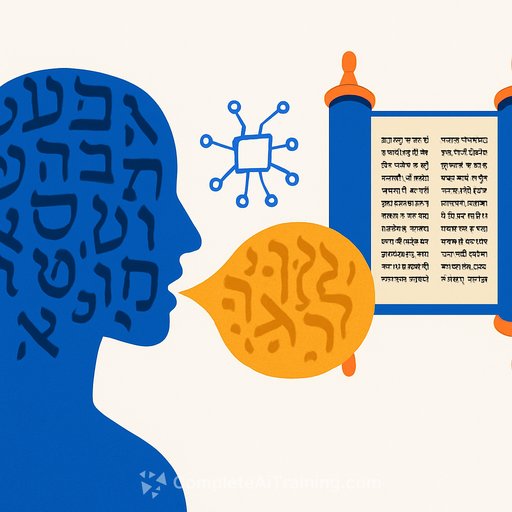Being Human in the Age of AI: Speech, Soul, and Integrity
Large language models can mimic us across essays, emails, and podcasts. They generate fluent talk. That raises a real question: if human identity rests on speech, what happens when machines speak too?
An old idea offers a clear frame. In Genesis, the world is created through Divine speech-"And G-d said… and it was." When it comes to humans, the script changes: "Let us make man," and then "G-d made the man." The word and the making no longer fuse. Humanity stands in a different relationship to speech-and to source.
Part I - Being and Humanity
Classical commentary marks a sharp line: animals are "living creatures," while Adam becomes a "speaking spirit." The human difference isn't higher IQ. It's speech as a core capacity.
Another distinction: animals appear fully formed from the earth. Adam's body is formed first; only afterward is the soul breathed in. Then, the human becomes a speaker. Meaning: eloquence emerges at embodiment, where soul meets dust.
Medieval sources push this further. The human soul isn't just created intellect; it's described as Divine breath. Not a product of speech, but the wellspring of speech. Two takeaways: the human soul is of Divine origin, and its definitive move-when embodied-is to speak.
Chassidic thought develops this into a practical model of language. There is public language-nature's fixed patterns, the already-spoken. And there is private language-new articulation from within, the inner capacity to speak across gaps. Humans are tasked with carrying the unspoken into the spoken, turning transcendence into sentences.
Part II - Soul and Language
Two classic models describe body and soul. Aristotle: the soul is the form of the body, a unifying principle. Descartes: the soul (mind) and body are different substances. Animals fit the Aristotelian mold: body and soul arrive together, commensurate.
Humans do not. The human soul and body are so unlike that their union is a leap. That's why the text splits the creation into stages. Language is the bridge.
Here's the key claim: language isn't a byproduct of thinking. Words are not just labels pasted on ideas. The "letters" of speech are described as rooted in the essence of the soul-preverbal, pre-conceptual, yet fully communicative. The human being is "filled with letters."
When those inner letters move into thought and speech, a gap appears between essence and expression. Yet expression still clings to source, like ink held by parchment. The forms vary; the meaning can remain one. This is how humans cross divides-by speaking from depth, not just from pattern.
So instead of a hard binary-form vs. matter, mind vs. body-this model treats the soul as an interface. It carries meaning across divides and makes coherence possible. It's how inner truth becomes shareable.
Part III - Superficiality and Integrity
Speech can be superficial (trained output) or integral (sourced in essence). Parrots and telephones can produce words. They don't speak. The difference isn't intelligibility-it's origin.
Human speech, at its best, is not produced by a vocal system alone, or even by cognition alone. It emerges from the core self. A statement voiced with integrity shapes identity. It isn't just communication-it is formation.
A classic contrast drives this home. Angels are described as acting "as if" they ate when visiting Abraham; Moses, in heaven, truly did not eat. Angels, in this frame, represent the outer form of language-appearance. The human soul represents inner meaning-integrity. Words have shells and cores. Without inner meaning, the shell is empty noise.
Implications for AI, Science, and Research
LLMs are expert in public language. They model patterns we've already spoken. That's useful. But human value lives in private language-in bridging gaps with intent, conscience, and first principles.
So the practical test is simple: where does a piece of speech source its meaning? If it comes from pattern alone, it is surface-level. If it comes from a clear inner stance-truths you're willing to stand behind-it carries weight.
For work that matters-papers, reviews, grant proposals, protocols, and policy-treat AI as a pattern amplifier, not as an identity substitute. Use it to draft, summarize, and structure, then inject the one thing it cannot supply: your integrity.
A Short Playbook
- Define intent first. One sentence: what are you trying to say, and why does it matter?
- Cross the gap. Note the tension between your core view and prevailing norms. Address it directly.
- Use AI for the public layer. Draft structure, surface literature, suggest variations.
- Add the private layer. Insert your assumptions, constraints, and non-negotiables.
- Check provenance. For every key claim, ask: what is the source? citation, data, or pattern?
- Audit voice. Do the words still sound like you would say them in a room of peers?
Why This Matters
Integrity in speech isn't a stylistic preference. It's how humans locate themselves amid noise. Without it, communication collapses into mimicry. With it, ideas land, teams align, and research advances with clarity.
As one essayist put it, the "variousness" of the self forces us to find the fundamentals. That is the work of speaking from the core, then selecting the right form to carry it.
Further Reading
Build Better LLM Workflows
If you want practical ways to pair AI's public language with your private intent-prompt patterns, review checklists, and role-based workflows-see these resources:
Your membership also unlocks:






